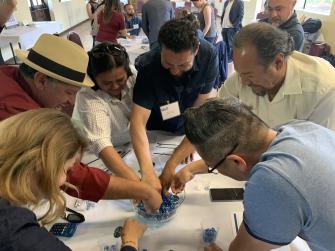The Groundwater Game
A fun, hands-on simulation of the challenges and solution strategies of groundwater management
The Groundwater Game provides players with an interactive opportunity to experience the challenges of managing increasingly scarce groundwater when there are competing needs. The game also provides players with a greater understanding of different management tools, including groundwater trading.

The tool was co-developed through a social science research partnership with Environmental Defense Fund, University of Michigan professors Robert Goodspeed and Colleen Seifert, and Environmental Incentives in response to new groundwater legislation in California. Signed into law in 2014, California’s Sustainable Groundwater Management Act, or SGMA, requires local agencies to develop and implement groundwater sustainability plans to balance the supply and demand of their groundwater. Although these plans are much more complex than the Groundwater Game simulation, they will address the same problem and may use similar policy rules.
The game may be useful for SGMA implementation by engaging community members – a key requirement of SGMA – and fostering greater awareness of the multiple interests and perspectives surrounding groundwater resources.
Created with a variety of audiences in mind, the Groundwater Game has been played by hundreds of people, including water managers, farmers, environmental justice groups and other nonprofit organizations. Some materials are available in Spanish.
Game play
The game has six roles assigned to different players: almond grower, alfalfa grower, broccoli grower, rural family, community water system and urban water utility. A facilitator coordinates and tracks results on a pre-designed spreadsheet over five to six rounds of play, with each round representing a new year.
Players experiment with different groundwater pumping and management strategies, including unregulated pumping and allocations. In later rounds, participants experience how water trading affects the aquifer level and see whether players’ needs are met.
Partner perspective
The Groundwater Game helps stakeholders realize that their role in groundwater management should always be a cooperative one.
Alison Martin
Educator, Solano County










